#age of discovery
Text
The Orlop
Large merchant ships with a fixed deck are documented as early as the 13th century. This deck was called an averlop or overloop. In the course of the 17th and 18th centuries, the height of the deck in relation to the waterline changed. Until then, it was not only the lowest deck in general, but also the lowest gun deck. Below this began the so-called space, which could be divided by planking or could also have a light and therefore watertight deck. The overlop could be covered by a canopy. It is not clear from the sources whether this deck was given its own name. The term ‘Verdeck’ also generally refers to a deck and Dutch sources usually only contain descriptive lists of decks. In German usage in the 17th century, there is also no evidence of a distinction between decks by name. In Hamburg in 1685, all decks were described as overlop (‘overflow’). In Röding's dictionary of 1798, overlop is translated as overflow and generally as deck. In contrast, the English orlop is translated in the same work as Kuhbrücke ( cow bridge - where the cattle were housed) under the lowest deck.

Orlop deck of a ship of the line (in red), 1728, in: A Ship of War, Cyclopaedia, 1728, Vol 2
The orlop deck was used as an ideal storage area and at the same time as a recreation room for some of the ship's crew. As the deck did not have to be cleared or remodelled during combat operations, cabins and rooms located here were permanent and could even be locked. The purser could therefore store his valuable or dangerous items (small arms) here, and the surgeon his medical items (medicines, instruments), so that they were protected from unauthorised access. As the deck was below the waterline, it was one of the safest places on board during a battle. For this reason, the ship's surgeon often had his workshop down there, as he could do his work unhindered by the fighting and the wounded were brought to him on the orlop deck.
#naval history#naval artifacts#orlop deck#13th -19th century#age of sail#medieval seafaring#age of discovery#age of steam#just a small overview
65 notes
·
View notes
Text
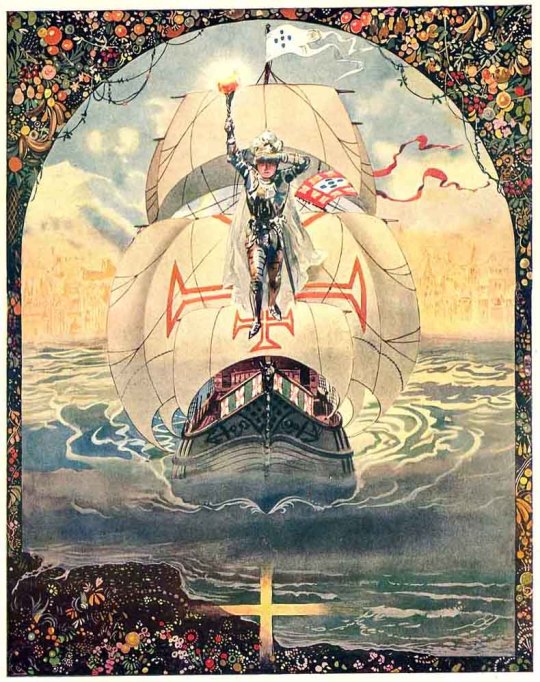
Frontispiece of "História da Colonização Portuguesa do Brasil"
Illustrated by Alfredo Roque Gameiro
#alfredo roque gameiro#art#portugal#portuguese#brazil#brasil#americas#new world#age of exploration#age of discovery#age of sail#conquest#europe#european#history#ship#ships#knight#torch#medieval#middle ages#torchbearer#armour
53 notes
·
View notes
Text
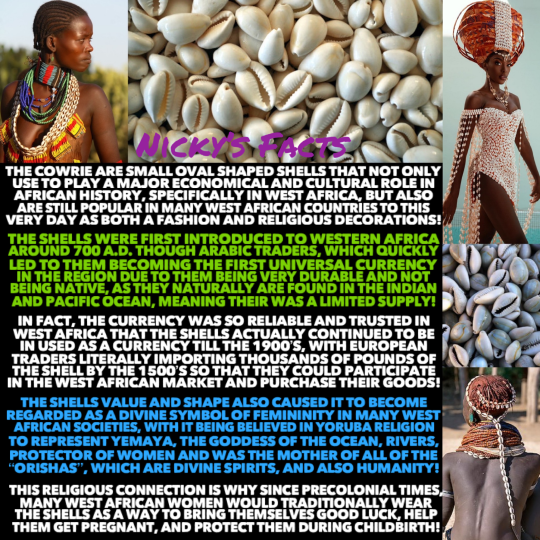
It’s amazing how many meanings one small shell can have!
🌊🐚
#history#cowries#africa#sea shells#currency#womens history#goddess#yemaya#black femininity#medieval#african history#age of discovery#cowrie shells#childbirth#african heritage#pre colonial#black girl magic#fertility#ocean#traditional femininity#black history#cottagecore#african women#yoruba#west africa#divine femininity#fashion#nickys facts
26 notes
·
View notes
Text
What I would most like to see in Hetalia would be to see Spain and England talking about the old glories...like the old empires where the sun never set...God...that would be interesting.
Like two old enemies sitting together and reminiscing about their past glories from when they were younger.
Himaruya just let them talk.
#aph england#hetalia#age of discovery#hetalia headcanons#hws#historical hetalia#hetalia fanart#Or maybe just a joke about it#arthur kirkland#antonio fernandez carriedo#spuk#Hetalia#engspa#aph spain
43 notes
·
View notes
Text



Richard Burton & John Hanning Speke | Mountains of the Moon (1990) | Part 2/2
#Mountains of the Moon#watch this if you haven't I'm a sobbing mess since yesterday#1990#mountains of the moon 1990#Richard Burton#John Hanning Speke#Patrick Bergin#Iain Glen#burton/speke#90s#cinema#movies#perioddrama#perioddramaedit#perioddramasource#perioddramacentral#adventure movies#homoerotism#homoerotic#aye-aye-captain gifs#age of discovery#not boat media
13 notes
·
View notes
Text
The Portuguese were the first to forge a truly global empire. During the Age of Exploration, its sailors spread across the globe, conquering much of what they found.
11 notes
·
View notes
Link
More than five centuries after it was formulated in a series of papal decrees, the Vatican issued a formal announcement on March 30 repudiating the Euro-supremacist “Doctrine of Discovery.” In essence, the “doctrine” said that all lands not occupied by “Christians” passed into the hands of the European conquerors as soon as they were “discovered,” and their inhabitants enslaved.
Composed of decrees issued between 1452 and 1497, it served as the quasi-legal justification for the expropriation of entire continents in the name of spreading the Catholic faith. The repudiation by the Pope is the culmination of decades of struggle by Indigenous peoples in the United States, Canada and around the world demanding its withdrawal.
But while the Pope has now renounced it, the U.S. Supreme Court has not. The high court continues to treat the “doctrine” as an integral basis of U.S. law, particularly in regard to the rights — or lack thereof — of Native peoples.
Most notable in recent times was a 2005 decision authored by the late liberal Justice Ruth Bader Ginsburg which invoked the “Doctrine of Discovery” in her majority ruling against the Oneida Indian Nation. The Oneidas were seeking to recover lands and rights in central New York State guaranteed to them under the 1794 Treaty of Canandaigua treaty with the U.S., signed by George Washington, then president.
The Oneidas, one of the six nations of the Haudenosaunee (Iroquois) Confederacy were awarded 300,000 acres “in perpetuity” by the treaty. By the 20th century, nearly all of that land had been taken over. In the 1970s, the Oneidas began buying small parcels on what had been their reservation land, including in the small city of Sherill, New York. They objected to the demand by the city that they pay property taxes on the basis that they were a sovereign nation. While the Oneidas won in lower federal courts, the Supreme Court ruled against them 8-1, with Ginsburg authoring the decision:
“Under the Doctrine of Discovery, title to the land occupied by Indians when the colonists arrived became vested in the sovereign – first the discovering European nation and later the original states and the United States . . .
“Given the longstanding non-Indian character of the area and its inhabitants, the regulatory authority constantly exercised by New York State and its counties and towns, and the Oneidas’ long delay in seeking judicial relief against parties other than the United States, we hold that the tribe cannot unilaterally revive its ancient sovereignty, in whole or in part, over the parcels at issue.”
In 2020, the Supreme Court by a 5-4 vote upheld the right of Native nations to reservations that would have included nearly half of Oklahoma. While this was a victory for a coalition of Native nations, right-wing justice Neil Gorsuch wrote the majority opinion upholding the government’s power to deny the right of self-determination to Indian peoples.
“Once a reservation is established, it retains that status until Congress explicitly indicates otherwise,” wrote Gorsuch. “Only Congress can alter the terms of an Indian treaty by diminishing a reservation, and its intent to do so must be clear and plain.”
How did a loathsome “doctrine” authored in feudal times come to have what liberal and conservative Supreme Court justices alike consider a legitimate basis in U.S. law?
It was the Supreme Court itself that incorporated the “doctrine” into U.S. law, which became foundational in dealing with Native nations, in a key 1823 case, Johnson v. McIntosh.
The decision by Chief Justice John Marshall, declared that, in keeping with the “Doctrine of Discovery,” Native people had only the “right to occupancy” of land and not the right to title or ownership. Only the federal government, Marshall ruled, could own and sell Native lands and that “the principle of discovery gave European nations an absolute right to New World lands”
Following the Vatican’s repudiation, the struggle will intensify for the U.S. government to do the same.
#indigenous peoples struggles#Doctrine of Discovery#Ruth Bader Ginsburg#us supreme court#the vatican#indigenous#genocide#land rights#article#imperialism#us imperialism#colonization#colonialism#age of discovery#history
58 notes
·
View notes
Text
National Anthem of the Kingdom of Spain (Marcha Real)
youtube
For some reason, this national anthem doesn't have lyrics. Still, it is a good melody that fully expresses the dignity of the nation. This is fitting for a country that reached the age of discovery earlier than any other European country.
スペイン王国国歌(国王行進曲 Marcha Real)
なんらかの理由で、この国歌には歌詞がつかないらしい。それでも、国家の威厳を十分に表現している、よい旋律である。ヨーロッパ諸国で、もっともはやく大航海時代を迎えた国に相応しい。
3 notes
·
View notes
Text
Numenera Campaign Concept: Gateway Terminal
Some thoughts for a Numenera Campaign, or possibly thoughts for an anthology of related Numenera Campaigns. Um. Okay. Has anyone here ever read the Heechee Saga, by Frederick Pohl? Specifically the novel ‘Gateway’?
Because. I wanted a campaign concept that originated in the Steadfast, just to play on the established infrastructure and worldbuilding. But. A lot of my favourite bits of the Steadfast are maritime or coastal. And Numenera is about discovery, in a couple of big ways. And the Steadfast, specifically, is broadly analogous to medieval Europe, with a techno-religious papacy holding a collection of feudal kingdoms together. And there’s the in-game category of ‘discoveries’, which are big pieces of prior world technology that are too big to be used by PCs and are of more worldbuilding impact, and one of the suggested discoveries is a ‘fully-functional hovertrain’. So. Transport systems are a type of discovery you can make. Including portal systems, there’s one that links the Steadfast to the Dawnlands, on the far side of Numenera’s supercontinent, that has only recently been discovered. But let’s go back maritime, ourselves.
So. The starter setting is the Steadfast. We’re a medieval society of nine kingdoms held together by a techno-papacy who has recently declared a crusade against our northern neighbours. We inhabit (though we don’t know this) a relatively small portion of the southwest corner of a massive Pangea-like supercontinent that, aside from at least one known island archipelago, is the only landmass in a vast world-spanning ocean. And recently, very recently, somebody made a discovery within our kingdoms that might change everything.
We found a hidden automated ancient ferry terminal. On our own shores. That contains several prior-world oceanic vessels designed to go to unknown and pre-programmed destinations.
Has anyone read the Heechee Saga? Gateway, the novel, is about humanity discovering an asteroid that was hollowed out by the Heechee, an unknown alien race, and this asteroid contains hundreds of pre-programmed starships. Each ship has a destination database, but no translations, so you can set a destination, but no-one knows where it goes to, and trying to change destinations mid-flight has, after considerable trial and error, always gone horrifically. So. You get in, you set your destination, and you roll the dice on whether the destination or the trip itself is survivable. Maybe you’ll find a viable habitable world. Maybe you’ll pick a destination that’s too far for that particular starship to reach. Maybe you’ll pick a destination that’s too far for your provisions to reach. Maybe you’ll pick one that’s lethal to humans, but was perfectly fine for Heechee. Maybe you’ll pick the one starship that’s secretly lethally broken after thousands of years without maintenance. You don’t know. So if you choose to get in one of these ships, you are choosing to gamble your life on the potential, the vanishingly small potential, of survival discovery.
And Numenera … Numenera is a setting about discovery. This world, this medieval Ninth World, is built on the strange, near-magical hyper-technology of a billion years of prior civilisations. Some spanned galaxies. Some rewrote the laws of reality. Some broke through to other dimensions. Some completely reshaped this planet in entirely literal ways. The known parts of the setting are a tiny corner of a single supercontinent on a world where literally anything could be waiting out there.
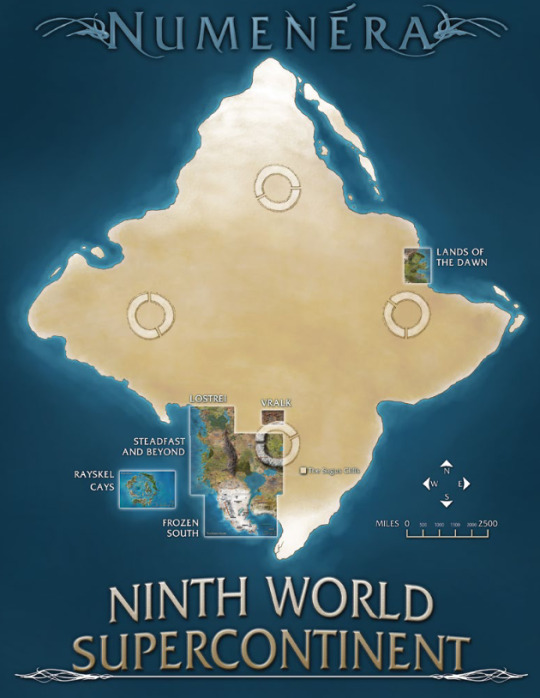
And I love the POV shift inherent in that. The medieval fantasy outlook of the current Ninth World layered over the mindboggling science fiction concepts of the prior worlds. And yes, this medieval fantasy world has adapted to the ruins of the ancients. They’ve built around them, they’ve made use of many of them, they’ve sensibly stayed clear of others. They know that these things exist, and that they’re vast and incomprehensible and also occasionally useful and potentially the sources of vast personal and political power, if they can be used right.
So going back to the Steadfast. Going back to this medieval collection of kingdoms, run by a papacy, perhaps not too far away from our historical Europe … on the verge of the age of discovery? With all the potentially horrific political consequences that could have. And this setting discovers … a gateway. An incredibly risky and potentially deadly gateway. To the entire rest of the unknown world. Or, well. At least some of it.
The thought I have for this is that someone, a small expedition, discovered a disguised artificial harbour carved back into what they thought was a known cliff face. Let’s say it was masked by hard light/holographic technology, so the cliff seemed fully real and physical and interactable, but if you could find the secret entrance, you could slip beyond it. Why was it disguised? Was it a military installation? Or was it an aesthetic consideration, to mask the environmental impact of the port behind a pretty hologram of the natural surroundings? Dealer’s choice. But there’s an entire artificial cavernous port behind that hologram, carved back and underground from the cliff face. Maybe it has an ancient lock system to raise vessels up to sea level to sail outwards, giving us room to expand below ground and make it massive without overly disturbing the land on the surface above it.
It was the discovery of a lifetime, and there was more. This vast artificial harbour contained ships. Strange prior-world ships. That appear to be somewhat alive, or at least capable of speaking. And these ships are still operable. I want to say that someone tried to activate one. Perhaps the ship’s AI asked them to, for its own reasons. But someone activated one of the smaller ships. Because I want someone to have realised that the ships are pre-programmed. It moved on complete autopilot through the lock system, made it to the surface, sailed out past the holographic cliff face, and then kept going. And nothing they could do could stop it once it was activated. It sailed off westwards into the open ocean, and literally no one has seen it since. The only reason we know about it is that one or several of the team that activated the ship jumped overboard when they realised they couldn’t stop it, and at least one survived to make it back to shore afterwards.
So. Here’s where we are now. A team of ruin-delvers in a Steadfast kingdom have reported finding a vast coastal facility. This facility contains prior world ships that can be activated, BUT cannot be controlled. These ships have minds of their own and unknown destinations that they’re pointed towards. And it’s possible that someone could board them, and discover what those destinations are.
I kind of want the ferry terminal to be in Ancuan. Specifically the Scorpion Reach peninsula. It does have the background for it: “This sprawling peninsula is filled with the ruins of the prior worlds. Known for its weirdness and mysteries, it is frequented by explorers, discoverers, and numenera scholars.” It’s full of weird shit and crawling with explorers, it would absolutely make sense for there to be teams in place to find this thing. But I want it to be in Ancuan because of the nearby presence of Kaparin and the Redfleets. An entire organisation of rogue pirate scientists and oceanographers. Because. They would jump on this. Not necessarily on the facility itself, or even the ships, the Redfleets don’t care much for numenera, but because of the potential for oceanic exploration. They’ve lost the capability to make their own submergine bioships now that their creator is dead. These ships have so much potential for them.
These ships have so much potential for a LOT of people. The facility is probably still broadly secret, but I think there’s five factions in particular that have picked up on it, and it’s massive political potentials.
The first is obviously the Amber Papacy, the Order of Truth. An aeon priest was likely one of the initial discoverers, and this is the Order’s whole deal. Prior world technology, understanding it for the betterment of all, and keeping hold of a political bombshell that could deeply damage the fragile peace between the kingdoms of the Steadfast. They’re going to be all over that.
Then the Convergence, the Order’s eternal foes, to control this new technology for themselves and their own causes.
Then Ancuan itself, as a kingdom. It’s theirs. It’s within their borders. It could potentially open up trade and expansion corridors to gods know where, it could let their kingdom win an edge over the others, particularly nearby expansionist nations like the Pytharon Empire. Ancuan tends to be a very self-sufficient kingdom that doesn’t pay a lot of attention to King Asour-Mantir, but he probably is interested in this discovery, and it’s potential ramifications.
The fourth is the Redfleets, because they’re right next door, and if anyone saw that first ill-fated voyage of an unknown ship in the vicinity, it was probably them. And this … this has so much potential for them. They want in.
And the fifth, I think, is the Sea Kingdom of Ghan. Because remaining the main source of maritime trade in the Steadfast is one of King Laird’s overriding concerns. He’s the one who’s interested in expeditions to find the rumoured archipelago of the Rayskel Cays and set up trade with them. Maritime exploration is a big deal to him and his people, as well as making sure that they’re the ones who go places first and set up trade routes with them. So if rumours reach him about a prior-world ship cache with pre-set trade routes, that would definitely be something he’d send people to investigate.
So there’s a lot of people interested in sending people to investigate this new discovery, both the facility and the ships inside it. There’s people interested in controlling this facility. There’s people interested in breaking into it. There’s people interested in hijacking one of these ships and just seeing where it goes. There’s people interested in launching official and well-planned, well-provisioned expeditions on these ships. There’s people interested in investigating the rest of the facility itself, the ferry terminal. Does it have connections to other facilities? Could communication exist between them? Is there something in the facility that would allow them to learn or even change the destinations of the ships? Would it have a database of where it’s sending things?
So there could be a campaign here, or an anthology of linked campaigns. Does the party want to go on an expedition? Do they want to explore the facility? Do they want to play a group determined to destroy it, to prevent invite risk and destruction on the Steadfast, or do they want to play a team sent to stop that from happening? Would they like to play spies sent from various Steadfast political powers to learn about and potentially use this facility themselves? Do they want to play the aftermath of a successful expedition?
Which. On that subject. Where are these ships going? And, for that matter, how many ships are there, and what kinds?
Because I’d say there’s a couple of big ones. Maybe three? About the size of modern passenger ferries or small cruise liners. There’s a couple of ships in there that could hold small cities worth of people, and outfitting those would be a massive undertaking, especially when you don’t know where or how far they’re going. How would you provision them? And on the bigger ships, especially when self-driven, they can also function as their own mini-dungeons, facilities to explore in their own right, with potentially a lot of secrets in their bowels.
Then there can be several of various smaller types of vessel. Submarines? Research vessels. Maybe things analogous to coast guard cutters or small military patrol vessels. Each with their own unique challenges and purposes, and thus internal arrangements and uses. Exploring each ship and its secrets can be its own whole set of quests, trying to identify what’s inside them all.
And then. If anyone wants to try activating them. If the PCs want to be sent on an expedition into the complete unknown. Where do these ships go? Some thoughts for that:
Short-range trips. Maybe some of the vessels, like the coast-guard equivalents, have patrol routes. Maybe there are facilities out there in the ocean very close to the Steadfast itself that no one knows about, and these ships can reveal them. Or some of them are automated ferries to relatively nearby areas. Say, in Lostrei? The lands north of the Cloudcrystal Skyfields that the Papacy has just declared a crusade on? You get on a ship and it sails you straight into enemy territory, what do you do? Does it sail you back? What does either your country or the enemy county do with that knowledge? Or maybe the ship sails south, past the Frozen Lands, into the strange polar seas. What do you find down there? Or does it go out to the Rayskel Cays or even other, unknown island chains, and thereby set up those potential trade routes the Sea Kingdom of Ghan wanted?
Long-range trips. What if one of the ships, probably one of the larger ones, is designed to circumnavigate the supercontinent? What if you get on this ship, and it literally circles your world. All that blank empty space on the map that you have no idea about, that in most cases, for an explorer from the Steadfast, you didn’t even know was there? You get on this ship, and maybe you’re never coming back, but you will see wonders before you die. Or there’s the open ocean. There’s all the wonders of the world away from the land. Is this continent the only one? If it is, what’s out there in the vast uninterrupted ocean on the far side of the world? What kind of facilities would the peoples of incredibly technological prior worlds have put out there where there are no people to be hurt? If you have a planet where all the civilian inhabitants are on one half, what do you put on the other?
And then there’s other sorts of trip. A lot of these, if we’re imagining a transport hub facility, would be known routes. The fully automated ships, sailing common routes to nearby or further afield locations. But maybe a couple, one or two, of these ships are not fully automated the same way. Maybe they have more independent AIs or other means of choosing their destinations. Maybe some of them are research vessels. Maybe they’re designed to roam relatively freely, and just examine things. I’m sure if the Redfleet could ID one of those, they’d be delighted to take it over.
I know, this isn’t really a set campaign as such, it’s more of a setting element that I want to throw into the world and then build probably several campaigns around. But. It’d be cool, right? You could gauge what your players are vibing with. Have them pick a faction, the Redfleets or the Aeon Priests or the Sea Kingdom of Ghan. Or independent Ancuani pirates who’ve gotten wind. Do they want to play politics, or roll the dice on potentially vast exploration? Do they want to start small, just figuring out what one of these ships is? Or is it high exploration on an unknown vessel with potentially lethal lurking secrets after a million years without maintenance sailing out on a potentially one-way trip to god knows where? Are you a Redfleet crew bringing several of their own smaller submergines onboard for the finest oceanographic expedition ever mounted? Are you a small group of spies trying to infiltrate this facility on behalf of the Sea Kingdom of Ghan, or the Convergence? Are you a group of Aeon Priests delving into the bowels of the hidden port itself in search of secrets or databases or ship manufacturing facilities? Are you all members of a cult who want to take one of the huge ships and build a seafaring kingdom of your own, like Taracal, out in the wild blue yonder?
IDK, I feel like there’s potential there, for a lot of things. I wouldn’t mind playing around with the idea. Heh. An oceanic Numenera campaign centered on a lost prior world automated ferry terminal.
Numenera: The Gateway Terminal.
#numenera#campaign concept#ttrpgs#discovery#heechee saga#maritime exploration#age of discovery#fun with worldbuilding
5 notes
·
View notes
Audio
Sam Spence - Age of Discovery
Plays in:
39b. "The Fry Cook Games"
#spongebob#spongebob squarepants#my audio#music#apm track#The Fry Cook Games#Age of Discovery#Sam Spence
7 notes
·
View notes
Text
Carrack Nao Victoria
2K notes
·
View notes
Text
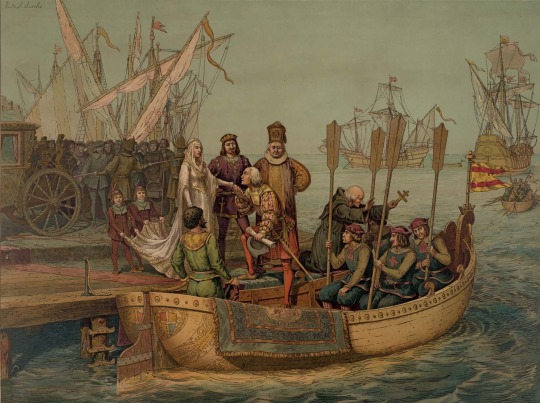
The First Voyage, Christopher Columbus bidding farewell to Queen Isabella I on his departure for the New World, 3 August, 1492.
by Victor A. Searles
#christopher columbus#isabella i#ferdinand ii#spain#palos#spanish#art#victor a searles#new world#history#age of sail#age of exploration#age of discovery#explorer#exploration#europe#european#america#americas#christianity#christian#royal#royalty#ships#boat#port#niña#pinta#santa maria#watercolour
100 notes
·
View notes
Text
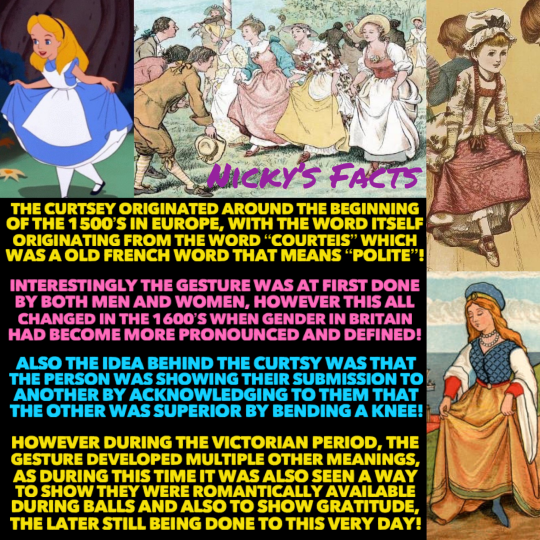
The origins behind a major part of Princess etiquette!
👸🏻👑👸🏾
#history#curtsey#princess#polite#bend the knee#age of discovery#womens history#britain#femininity#girly things#womenhood#princesscore#victorian#soft girl#sapphic#princess aesthetic#cottagecore#european history#girlhood#royalty#respect#girly girl#victorian history#language#lady like#nickys facts
52 notes
·
View notes
Text

“Je resserre ma paire avant mon tête”
#new balance#bodega#new balance 9060#age of discovery#kicks#sneakers#footwear#style#debonair#nonchalant#mood
14 notes
·
View notes
Text





Richard Burton & John Hanning Speke | Mountains of the Moon (1990) | Part 1/2
#not strictly related to this blog but it is a period drama so it kinda fits#and men in fluffy sleeves being kind to eachother#i thought about posting this on my main first but it seemed to fit here more#BUT I FORGOT to change the watermark 🤡 and idk when I'll be able to make these again so I'll just leave it be#I just fell in love with this movie so i had to make these#Mountains of the Moon#1990#mountains of the moon 1990#Richard Burton#John Hanning Speke#Patrick Bergin#Iain Glen#burton/speke#90s#cinema#movies#perioddrama#perioddramaedit#perioddramasource#perioddramacentral#aye aye captain gifs#adventure movies#homoerotism#homoerotic#aye-aye-captain gifs#age of discovery#whump#not boat media
7 notes
·
View notes
Text
The 1500s were a transformative period for Europe. The intellectual resurgence after the Black Death brought on the Renaissance and the advancements that ushered in the Modern Era.
10 notes
·
View notes